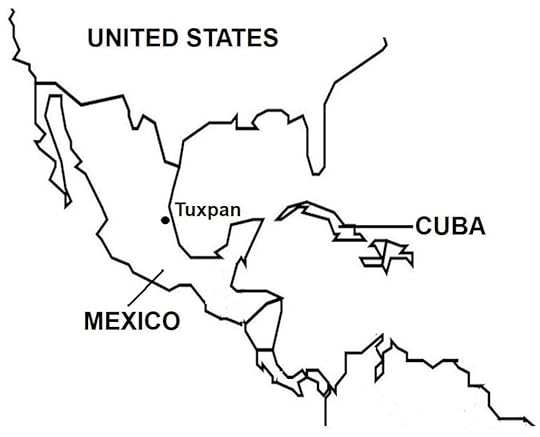December 2, 1956 – Cuban Revolution: Fidel Castro and his men arrive at Playa Las Coloradas in southeastern Cuba
On December 2, 1956, Fidel Castro and his men arrived insoutheastern Cuba,with their vessel hitting a sandbar close to the mangrove shoreline of PlayaLas Coloradas. The Cuban military,having recently increased its operations in the region because of the recentM-26-7 attacks, spotted the landing and fired on the Granma. Fidel Castro and his men made it to shore,but were forced to abandon most of their weapons and supplies still on boardthe vessel. While making their way tothe Sierra Maestra Mountains,they were ambushed on December 5 by a large army contingent. Eventually, less than 20 of the original 82rebels met up deep in the forested highlands; the survivors included thegroup’s leaders Fidel and Raul Castro, Guevara, and Camilo Cienfuegos, whilemost of the rebels had been killed or captured.
 In November 1956, Fidel Castro and 81 other rebels set out from Tuxpan, Mexico aboard a decrepit yacht for their nearly 2,000 kilometer trip across the Caribbean Sea bound for south-eastern Cuba.
In November 1956, Fidel Castro and 81 other rebels set out from Tuxpan, Mexico aboard a decrepit yacht for their nearly 2,000 kilometer trip across the Caribbean Sea bound for south-eastern Cuba.Fidel Castro soon established his headquarters in the SierraMaestra, and in the following months, launched attacks against army patrols andisolated outposts, and on government and public infrastructures, therebygaining control of much of the mountainous region and later expanding therevolution’s “liberated zones”. Heincreased the size of his force by recruiting from nearby villages and fromurban volunteers who were drawn to his cause. The revolution was boosted greatly by the “escopeteros”, localsupporters who served many auxiliary roles: as armed irregulars to the M-26-7main force, as informants providing the positions and movements of army units,and as porters carrying supplies across the mountains.
(Taken from Cuban Revolution – Wars of the 20th Century – Volume 2)
Background InMarch 1952, General Fulgencio Batista seized power in Cuba through a coup d’état. He then canceled the elections scheduled forJune 1952, where he was running for the presidency but trailed in the polls andfaced likely defeat. Having gainedpower, General Batista established a dictatorship, suppressed the opposition,and suspended the constitution and many civil liberties. Then in the November 1954 general electionsthat were boycotted by the political opposition, General Batista won the presidencyand thus became Cuba’sofficial head of state.
President Batista favored a close working relationship with Cuba’s wealthy elite, particularly with Americanbusinesses, which had an established, dominating presence in Cuba. Since the early twentieth century, the UnitedStates had maintained political, economic, and military control over Cuba; e.g.during the first few decades of the 1900s, U.S. forces often interveneddirectly in Cuba by quelling unrest and violence, and restoring politicalorder.
American corporations held a monopoly on the Cuban economy,dominating the production and commercial trade of the island’s main export,sugar, as well as other agricultural products, the mining and petroleumindustries, and public utilities. The United Statesnaturally entered into political, economic, and military alliances with andbacked the Cuban government; in the context of the Cold War, successive Cubangovernments after World War II were anti-communist and staunchly pro-American.
President Batista expanded the businesses of the Americanmafia in Cuba, where thesecriminal organizations built and operated racetracks, casinos, nightclubs, andhotels in Havanawith relaxed tax laws provided by the Cuban government. President Batista amassed a large personalfortune from these transactions, and Havanawas transformed into and became internationally known for its red-lightdistrict, where gambling, prostitution, and illegal drugs were rampant. President Batista’s regime was characterizedby widespread corruption, as public officials and the police benefitted frombribes from the American crime syndicates as well as from outright embezzlementof government funds.
Cubadid achieve consistently high economic growth under President Batista, but muchof the wealth was concentrated in the upper class, and a great divide existedbetween the small, wealthy elite and the masses of the urban poor and landlesspeasants. (Cuban society also containeda relatively dynamic middle class that included doctors, lawyers, and manyother working professionals.)
President Batista was extremely unpopular among the generalpopulation, because he had gained power through force and made unequal economicpolicies. As a result, Havana(Cuba’scapital) seethed with discontent, with street demonstrations, protests, and riotsoccurring frequently. In response,President Batista deployed security forces to suppress dissenting elements,particularly those that advocated Marxist ideology. The government’s secret police regularlycarried out extrajudicial executions and forced disappearances, as well asarbitrary arrests, detentions, and tortures. Some 20,000 persons were killed or disappeared during the Batistaregime.
In 1953, a young lawyer and former student leader namedFidel Castro emerged to lead what ultimately would be the most seriouschallenge to President Batista. Castropreviously had taken part in the aborted overthrow of the Dominican Republic’s dictator Rafael Trujilloand in the 1948 civil disturbance (known as “Bogotazo”) in Bogota,Colombia before completinghis law studies at the University of Havana. Castro had run as an independent for Congressin the 1952 elections that were cancelled because of Batista’s coup. Castro was infuriated and began makingpreparations to overthrow what he declared was the illegitimate Batista regimethat had seized power from a democratically elected government. Fidel organized an armed insurgent group,“The Movement”, whose aim was to overthrow President Batista. At its peak, “The Movement” would comprise1,200 members in its civilian and military wings.



